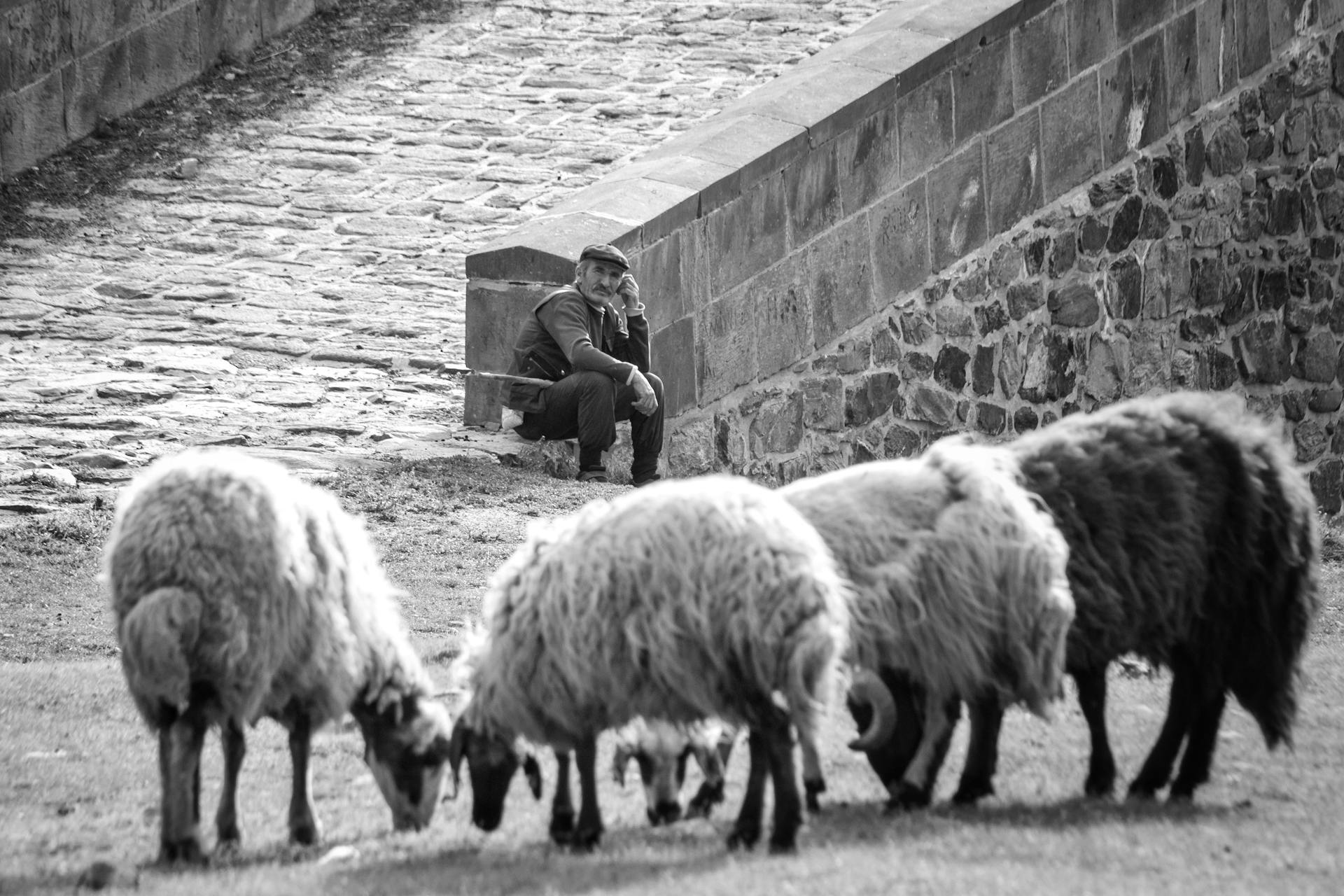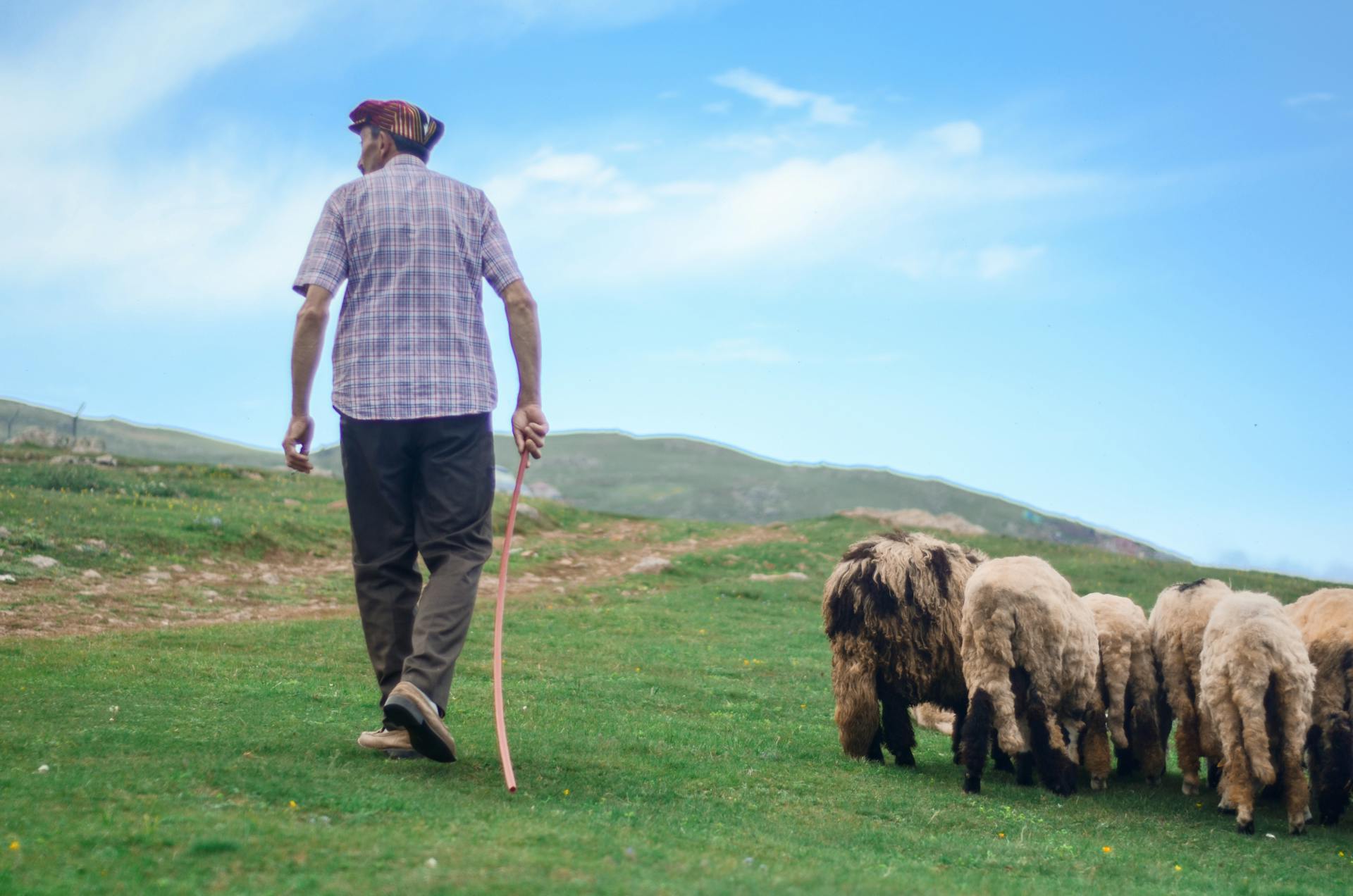
The East European Shepherd is a robust breed that requires regular exercise to maintain its physical and mental health. They need at least 30 minutes of exercise per day, which can include running, hiking, or playing fetch.
Their thick double coat sheds heavily, especially during shedding season, so regular grooming is a must. They need to be brushed at least 2-3 times a week to prevent matting and tangling.
East European Shepherds are prone to hip dysplasia, a genetic condition that can lead to arthritis and mobility issues. Early detection and regular veterinary check-ups can help identify any potential issues.
Their high energy levels mean they're not suitable for apartment living, but with the right owner, they can thrive in a spacious home with a large yard.
Explore further: Do Border Collies Need to Be Groomed
Breed History
The East European Shepherd was developed in the Soviet Union in the early 20th century.
The breed was created by crossing German Shepherds with hardy Russian breeds, such as the East Siberian Laika, Caucasian Shepherd, and Central Asian Shepherd.
See what others are reading: East Siberian Laika
In the 1920s, German Shepherds were imported from Germany into the Ukrainian SSR, where a breeding program was established to adapt the breed to the harsh Soviet climate.
The East European Shepherd was initially bred in Ukraine, but soon spread throughout the Soviet Union.
The breed was heavily used by the military and police within the Soviet Union as a guard and sniffer dog.
The KGB was particularly fond of the East European Shepherd, and only kept solid black examples, destroying any non-black pups in a litter.
A breed standard was approved in 1955 by the Central Committee of the USSR DOSAAF, and in 1964 by the Presidium of the Service Dog Breeding Federation.
The East European Shepherd is now among the most numerous dog breeds in Russia and several former Soviet countries.
The breed's development started around the 1930s, with the Soviet military wanting to create a dog that was similar to the German Shepherd but could adapt to the colder, harsher climate.
The East European Shepherd was originally called the Byelorussian Owtcharka, but resumed development after World War II and resulted in a new breed for the Soviets.
The breed was rapidly assimilated into the military and became the main dog used by the KGB service.
The East European Shepherd has a tempered protective instinct and a balanced character, with a wary and aggressive reaction to intruders and utmost loyalty and affection to their owner.
Consider reading: German Military Dogs
Health and Maintenance
The East European Shepherd is a relatively healthy breed, but like all large dog breeds, they can be prone to certain health issues. They have fewer hip and elbow problems compared to German Shepherds, thanks to their straighter toplines.
Regular veterinary check-ups are essential to monitor their health. A typical health check for an East European Shepherd includes an ear examination, blood analysis, regular full physical examination by a veterinarian, serum chemistry tests, and hip and elbow X-rays.
To keep their thick coat in good condition, they require regular brushing, at least twice a week. Bathing is not often necessary, but if it's done, a mild dog shampoo should be used to maintain the natural oil protection in their coat.
Health
The East European Shepherd is a relatively healthy breed, thanks to its breeding history. They were bred with toplines that have less angulation, which has led to fewer hip and elbow problems compared to German Shepherds.

This is especially true for the DDR and Czech working line German Shepherds, which have good toplines and spines like the VEO breed standard.
However, like German Shepherds, East European Shepherds can still develop hip and elbow dysplasia. This is a common issue in large dog breeds, and it's essential to monitor their health closely.
Regular check-ups with a veterinarian are crucial to identify any potential health issues early on. Your vet may recommend the following tests:
- Ear Examination
- Blood Analysis
- Regular Full Physical Examination By Veterinarian
- Serum Chemistry Tests
- Hip and Elbow X-rays
By staying on top of your East European Shepherd's health, you can help prevent or catch any potential issues before they become serious problems.
Breed Maintenance
The East European Shepherd is a high-maintenance breed when it comes to grooming. They require brushing at least twice a week to keep their dense, thick coat in good condition.
Their thick coat is made up of a soft undercoat that sheds constantly, so be prepared for a lot of dog hair in the house. Bathing is not often required, but if you do need to bathe them, use a mild dog shampoo to avoid stripping their coat of its natural oils.
Regular exercise is essential for the East European Shepherd, and they need a job to do, such as watching over the property, to keep them happy and fulfilled. This breed is not suited for a sedentary lifestyle.
Some breeds that require similar maintenance to the East European Shepherd include the Bruno Jura Hound, Miniature Schnoxie, Slovakian Rough-haired Pointer, Bouvier des Flandres, and American Mastiff.
Here are some breeds that are similar in maintenance requirements:
It's essential to train your East European Shepherd from an early age to get them used to regular grooming, such as brushing their teeth and clipping their nails. This will make their grooming sessions much easier and less stressful for both you and your dog.
Worth a look: Dog Breeds That Don't Need Grooming
Temperament and Training
East European Shepherds are highly intelligent and trainable, but they require firm handling from a strong leader/owner. They need a combination of positive and negative reinforcement in their training, as positive reinforcement alone may not work.
Their strong prey drive means they're prone to chasing other animals, so it's best to keep them as lone pets. They're also wary of strangers and prone to protect first rather than hang back, which makes them great guard dogs.
East European Shepherds are versatile, hardy, loyal, protective, and playful, making them a fun family companion. They're highly trainable, but early socialization is crucial to help them get along with other dogs, pets, and small children in the household.
Intriguing read: Corgis as Pets
Temperament and Socialization
East European Shepherds are naturally protective of their family and property, making them excellent guard dogs. They are also very loyal and affectionate towards their family members.
These dogs are intelligent and need a strong leader to bring out the best in them. Without proper guidance, they can be a bit stubborn.
Early socialization is crucial for East European Shepherds, especially when it comes to interacting with other dogs, pets, and small children. This helps them understand acceptable behavior and reduces the risk of aggression.
Their strong prey drive means they can be prone to chasing other animals, so it's best to keep them as a lone pet. With the right owner, however, they make for a loyal and sensitive companion.
East European Shepherds are naturally wary of strangers and may protect themselves or their family first, which can be a great asset in a guard dog but not so desirable in a pet. With proper training and socialization, they can learn to let their guard down and be more confident around new people.
A fresh viewpoint: Are German Shepherds Clingy
Trainability
The East European Shepherd is highly trainable, but they need firm handling from a strong leader/owner. They are intelligent dogs that thrive on having a job to do.
Their intelligence and love for work make them highly trainable with the correct motivation. This means they'll respond well to reward-based training methods.
However, their natural strength of character will make them challenge for leadership, so they need special handling. Positive reinforcement "only" training doesn't work with many working dogs, a combination of positive and negative reinforcement is needed.
Obedience training is important and should be ongoing throughout the dog's lifespan to provide vital mental stimulation and remind them who's in charge.
A unique perspective: How Much Exercise Do Border Collies Need
Physical Characteristics
The East European Shepherd is a large and athletic dog, with males typically standing between 67 to 72 cm (26 to 28 in) at the withers, and females slightly shorter at 62 to 67 cm (24 to 26 in).
Their coat is a key feature, being dense and of medium length, with a well-developed undercoat that helps protect them from freezing temperatures. The ears are long and upright, adding to their distinctive appearance.
One of the most striking features of the East European Shepherd is their coat color, which can range from solid black to black and tan, with a black mask, or even sable grey or red. They also come in a range of other colors, including solid liver, blue, and silver.
The breed's physique is muscular but not stocky, with strong straight legs and a deep but narrow chest. Their waist is tucked up, and their back slopes slightly towards their long, thickly furred tail.
Here are some of the common coat colors found in the East European Shepherd breed:
Owner Experiences and Similar Breeds
As an East European Shepherd owner, you're not alone in your journey. The breed's unique characteristics have drawn comparisons to other maintenance breeds. For instance, the East European Shepherd shares a 100% similarity with the Bruno Jura Hound.
If you're looking for a breed that's similar in maintenance needs, consider the following breeds: Bruno Jura Hound, Miniature Schnoxie, Slovakian Rough-haired Pointer, Bouvier des Flandres, and American Mastiff, all of which are 100% similar to the East European Shepherd.
Some owners have reported confusion about the correct height of the East European Shepherd, with some sources citing 28 inches and others 30 inches.
For more insights, see: Low Maintenance Hypoallergenic Dogs
Owner Experiences
As an owner of an East European Shepherd, you'll want to know what to expect from this breed. The correct height of the VEO dog is 28 inches, not 30 inches, so you can stop searching the internet for clarification.
Many owners have expressed confusion about the dog's height, but fortunately, this is now settled. The East European Shepherd is a medium-sized dog.
You'll need to be prepared for regular grooming sessions to keep your East European Shepherd's coat looking its best. The breed requires regular brushing to prevent matting and tangling.
Some owners have reported that their East European Shepherds are highly intelligent and trainable, making them a great choice for first-time dog owners. With patience and consistency, you can teach your dog to obey basic commands and behave well in public.
As for exercise needs, East European Shepherds are relatively high-energy dogs and require regular physical activity to stay happy and healthy. A daily walk and playtime should be sufficient, but some owners may need to provide additional exercise to keep their dogs satisfied.
Check this out: Are Portuguese Water Dogs Good for First Time Owners
Similarly Sized Breeds
If you're considering bringing an East European Shepherd into your family, you may be wondering what other breeds are similar in size. For example, the Rafeiro Do Alentejo is 97% similar in size, making it a great alternative to consider.
Explore further: Dogs Similar to Border Collies

The Karakachan and American Blue Gascon Hound are also 96% similar in size, which means they'll likely require similar living arrangements and exercise needs.
If you're looking for a breed that's even more similar in size, the Bernese Mountain Dog and Great Bernese are both 96% similar, making them great options to consider.
Similar Maintenance Breeds
If you're looking for breeds that require similar maintenance to the East European Shepherd, you'll want to consider the following options.
The Bruno Jura Hound is a great match, as it requires the same level of exercise and attention as the East European Shepherd.
The Miniature Schnoxie is another breed that shares similarities with the East European Shepherd, requiring regular grooming and a high-energy lifestyle.
The Slovakian Rough-haired Pointer is a great choice for active owners who want a breed that can keep up with their East European Shepherd.
The Bouvier des Flandres is a sturdy breed that requires regular exercise and grooming, making it a good match for East European Shepherd owners.
Suggestion: Dogs Breeds That Start with B

The American Mastiff is a large breed that needs regular exercise and attention, similar to the East European Shepherd.
If you're considering one of these breeds, here are some key similarities to keep in mind:
These breeds all require a significant amount of attention and exercise, making them a good fit for owners who are willing to put in the work.
Cross-Breeds
The EES is a rare breed outside of its native Russia, which can make it challenging to find cross-breed options. This is because breeders prioritize maintaining the breed's purity to reduce the likelihood of hip dysplasia in future generations.
The focus on preserving the breed's purity means that outcrossing is not a primary consideration for EES breeders.
Frequently Asked Questions
What colors are Eastern European shepherds?
Eastern European Shepherds typically come in black and tan/silver, solid black, or sable coat colors. Their distinctive coat colors are just one of the many interesting characteristics of this breed.
Featured Images: pexels.com


